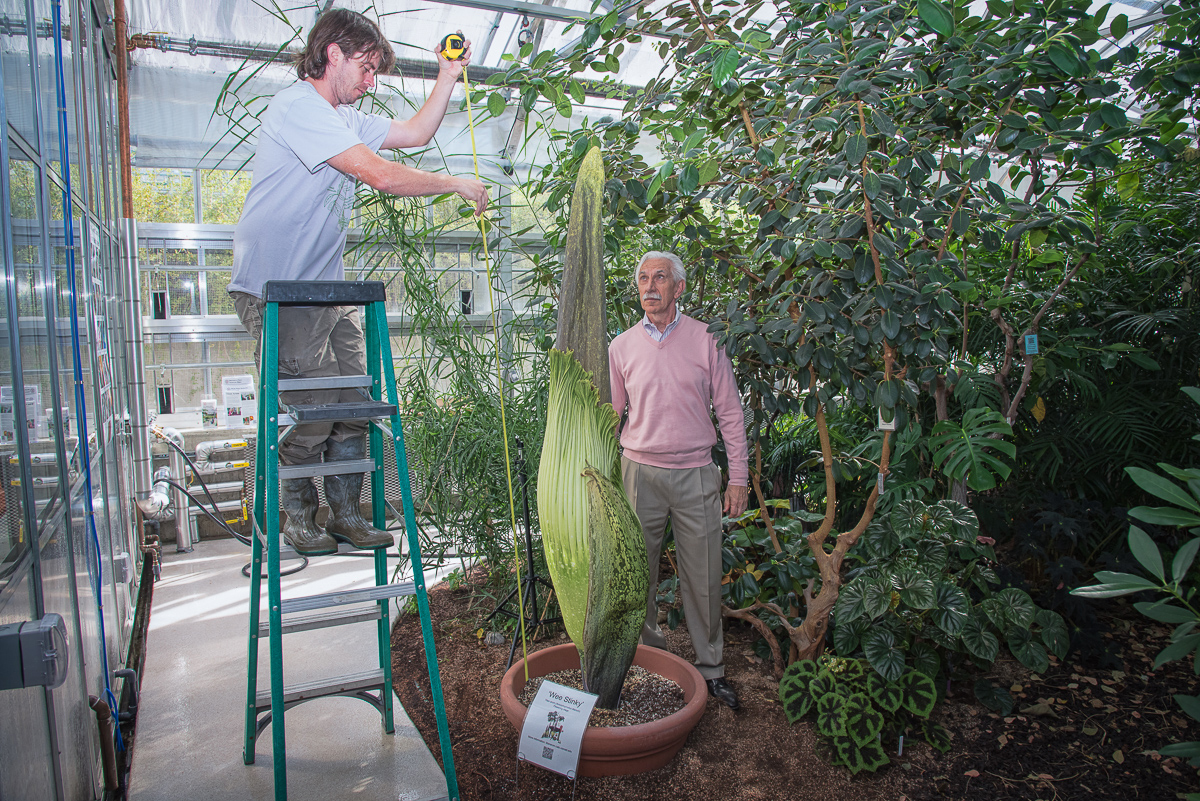Bigger than ever, Cornell corpse flower poised to bloom
By Matt Hayes and Craig Cramer

One of Cornell’s famous corpse flowers is getting ready once again to unfurl its fetid bloom.
The plant nicknamed Wee Stinky, one of two flowering-sized titan arums in the living collection of the Liberty Hyde Bailey Conservatory, is prepping for a dazzling reproductive effort to make itself big, hot and smelly.
Called a corpse flower for the putrid aroma unleashed when it flowers, the titan arum has evolved a reproductive strategy to lure pollinators with pungent signals akin to rotting flesh. Dark purple coloring, a sickly scent, blasts of heat and plumes of carbon dioxide are all deployed to resemble carrion favored by certain pollinator insects. It takes years for the plant to build up the necessary energy to put on such a macabre display, only to burn it all off in a few days before wilting back to a vegetative state.
The majestic plant can be seen — and, once it flowers, smelled — at the Liberty Hyde Bailey Conservatory. The conservatory is open to the public most weekdays from 10 a.m. to 3 p.m. When flowering starts, the Conservatory hours will be extended until 9 p.m. The next day, the conservatory will open at 9 a.m. (10 a.m. if it’s on the weekend) and remain open until 9 p.m. Check the titan arum or conservatory websites for updated hours and visitor information.
Already Wee Stinky is bigger than any previous titan arum bloom at Cornell.
In July the conservatory’s head grower, Paul Cooper, planted a 65-pound corm, the underground tuber-like structure where titan arums store energy. When Wee Stinky last bloomed in November 2014, it emerged from a 50-pound corm. That year the spadix, a column-like structure in the middle of the plant, reached 76 inches in height.
Wee Stinky has already topped that, measuring 81.5 inches as of Oct. 10, more than tripling in height in three weeks. As flowering nears, growth of the spadix slows.
Titan arums are known for being unpredictable, and while there is no way to tell exactly when it will flower, predictions are before Oct. 15.
Rob Raguso, professor and chair of the Department of Neurobiology and Behavior who has studied Cornell’s corpse plants, says the coordination demonstrated by the organism during flowering is a biological marvel.
“The titan arum is a super-sized example of the kinds of integrated physiological machines that all plants are. And they have lessons for us to learn,” he says.
Those lessons aren’t restricted just to botany, according to Raguso. He says these plants provide blueprints about how to coordinate complicated systems that could be useful for humans. Engineers interested in machine learning or in the development of technologies like smart appliances might be able to learn from these plants, Raguso says: “The molecular switches needed to demonstrate such exquisite temporal and spatial control of its physiology are astounding.”
During flowering, certain parts of the plant get hot – when Wee Stinky last flowered in 2014, its central spadix spiked in temperature to more than 106 degrees – while other plant parts remain at normal temperatures.
“It’s just plant tissue, yet there is precise control of thermal biology timed to peak at midnight,” he says.
That mechanism could be a form of convection heating to create thermal updrafts that drive the scent molecules toward the canopy. While still theoretical, that convection heating could be an evolved strategy to lure flies and winged beetles rather than insects that crawl on the tropical forest floor of Sumatra, where the plant originates.
A better understanding of those chemicals could also have potential benefit for humans. Raguso thinks reverse engineering the plant’s chemical weaponry could help humans in our ongoing battle against pests.
“These plants are offering more than a gothic horror story,” Raguso says. “They are showing us what it takes to trap insects and potentially control pests. The plants are already doing it, and doing it extraordinarily well.”
While scientists are fascinated by these odd plants, they also capture the imagination of the general public. More than 10,000 people visited Wee Stinky when it first flowered in 2012, and another 500,000 watched online. Large audiences flocked to see the plant flower again in 2014, as well as the flowering of Cornell’s other titan arum, named Carolus, in 2015.
The fact that Wee Stinky will be flowering for a third time in four years adds to the plant’s enduring mystery. Titan arums in cultivation have generally taken seven to 10 years to first bloom.
“To bloom at two-year intervals is unreal,” says Raguso. “No one has seen that before.”
Matt Hayes is managing editor and social media officer for the College of Agriculture and Life Sciences. Craig Cramer, communications specialist in the School of Integrative Plant Science, contributed to this report.
Media Contact
Get Cornell news delivered right to your inbox.
Subscribe